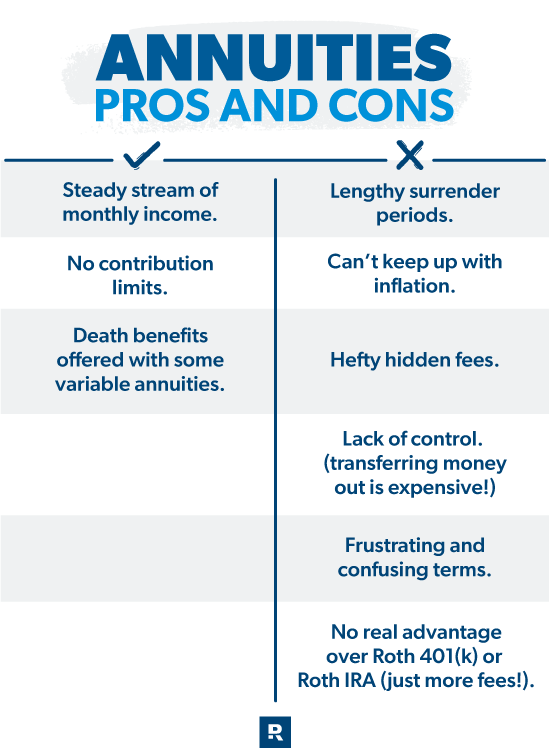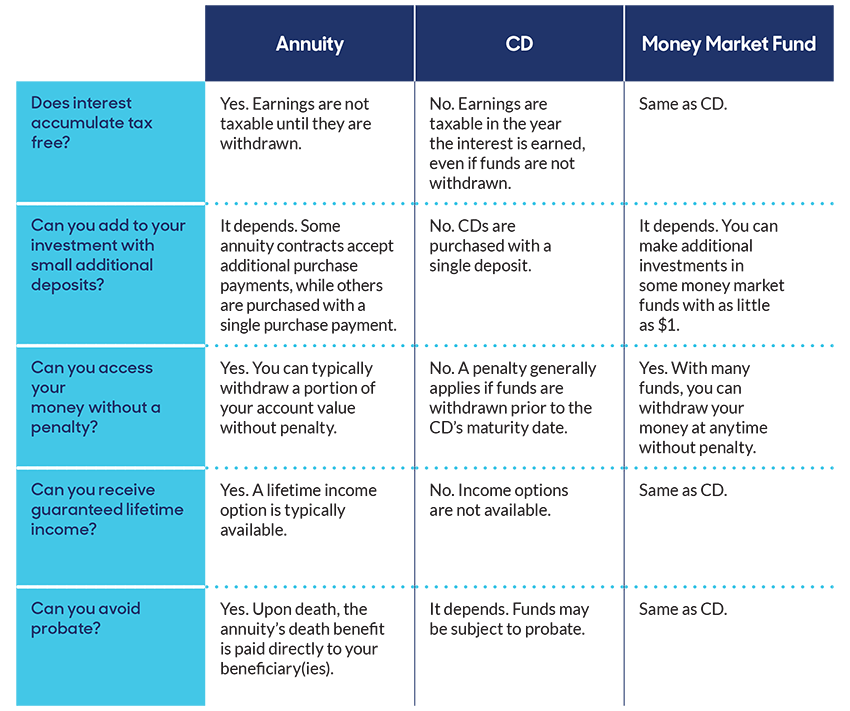All Categories
Featured
Table of Contents
The repayment might be spent for development for a lengthy period of timea single premium postponed annuityor spent momentarily, after which payment beginsa single premium immediate annuity. Single premium annuities are typically funded by rollovers or from the sale of an appreciated property. An adaptable premium annuity is an annuity that is planned to be moneyed by a collection of repayments.
Proprietors of repaired annuities recognize at the time of their acquisition what the value of the future capital will certainly be that are produced by the annuity. Clearly, the number of capital can not be known in advance (as this depends upon the agreement owner's lifespan), however the ensured, taken care of rates of interest at least gives the owner some level of certainty of future earnings from the annuity.
While this distinction seems basic and straightforward, it can considerably affect the value that an agreement proprietor eventually derives from his/her annuity, and it creates considerable uncertainty for the agreement owner - Choosing an annuity provider. It likewise commonly has a product effect on the level of fees that an agreement proprietor pays to the issuing insurance coverage business
Set annuities are typically used by older investors that have actually limited properties but who wish to counter the risk of outliving their properties. Fixed annuities can work as an effective device for this function, though not without certain disadvantages. For example, when it comes to prompt annuities, once a contract has actually been bought, the contract owner gives up any kind of and all control over the annuity assets.
Analyzing Strategic Retirement Planning Everything You Need to Know About Tax Benefits Of Fixed Vs Variable Annuities Defining the Right Financial Strategy Features of Smart Investment Choices Why Fixed Vs Variable Annuity Pros And Cons Is a Smart Choice How to Compare Different Investment Plans: A Complete Overview Key Differences Between Fixed Vs Variable Annuity Understanding the Rewards of Long-Term Investments Who Should Consider Strategic Financial Planning? Tips for Choosing the Best Investment Strategy FAQs About What Is Variable Annuity Vs Fixed Annuity Common Mistakes to Avoid When Planning Your Retirement Financial Planning Simplified: Understanding Your Options A Beginner’s Guide to Deferred Annuity Vs Variable Annuity A Closer Look at How to Build a Retirement Plan
A contract with a typical 10-year surrender duration would certainly charge a 10% surrender cost if the agreement was surrendered in the very first year, a 9% abandonment charge in the 2nd year, and so on till the abandonment fee gets to 0% in the agreement's 11th year. Some delayed annuity agreements consist of language that permits for little withdrawals to be made at different intervals throughout the abandonment period without penalty, though these allocations generally come with a cost in the type of lower surefire interest rates.
Equally as with a dealt with annuity, the proprietor of a variable annuity pays an insurer a lump sum or collection of payments in exchange for the assurance of a series of future repayments in return. As mentioned above, while a dealt with annuity grows at an assured, consistent rate, a variable annuity expands at a variable rate that depends upon the performance of the underlying financial investments, called sub-accounts.
Throughout the build-up phase, properties invested in variable annuity sub-accounts expand on a tax-deferred basis and are strained only when the agreement owner withdraws those revenues from the account. After the build-up phase comes the income phase. With time, variable annuity properties need to in theory enhance in worth till the agreement owner decides she or he wish to begin taking out money from the account.
The most substantial issue that variable annuities usually existing is high expense. Variable annuities have numerous layers of charges and expenditures that can, in aggregate, create a drag of up to 3-4% of the agreement's value each year.
M&E expense charges are computed as a percent of the contract worth Annuity issuers hand down recordkeeping and other administrative prices to the agreement proprietor. This can be in the form of a level yearly cost or a percentage of the agreement value. Management costs may be consisted of as part of the M&E risk fee or might be examined separately.
These costs can range from 0.1% for easy funds to 1.5% or more for proactively handled funds. Annuity contracts can be customized in a variety of ways to offer the particular needs of the contract owner. Some common variable annuity riders include guaranteed minimum accumulation advantage (GMAB), assured minimum withdrawal benefit (GMWB), and ensured minimum revenue benefit (GMIB).
Breaking Down Your Investment Choices Key Insights on Your Financial Future What Is the Best Retirement Option? Benefits of Choosing the Right Financial Plan Why Annuity Fixed Vs Variable Matters for Retirement Planning What Is Variable Annuity Vs Fixed Annuity: Simplified Key Differences Between Fixed Vs Variable Annuity Understanding the Risks of Long-Term Investments Who Should Consider Fixed Index Annuity Vs Variable Annuities? Tips for Choosing Variable Annuity Vs Fixed Indexed Annuity FAQs About Planning Your Financial Future Common Mistakes to Avoid When Planning Your Retirement Financial Planning Simplified: Understanding Your Options A Beginner’s Guide to Fixed Income Annuity Vs Variable Annuity A Closer Look at Variable Vs Fixed Annuities
Variable annuity payments provide no such tax obligation deduction. Variable annuities tend to be very ineffective vehicles for passing riches to the next generation due to the fact that they do not appreciate a cost-basis modification when the initial contract owner passes away. When the proprietor of a taxable investment account passes away, the price bases of the financial investments kept in the account are changed to reflect the marketplace prices of those financial investments at the time of the proprietor's death.
Such is not the situation with variable annuities. Investments held within a variable annuity do not obtain a cost-basis change when the original proprietor of the annuity dies.

One considerable problem related to variable annuities is the potential for conflicts of passion that might feed on the component of annuity salesmen. Unlike a monetary advisor, who has a fiduciary obligation to make financial investment choices that benefit the customer, an insurance broker has no such fiduciary obligation. Annuity sales are extremely lucrative for the insurance policy experts who sell them due to high upfront sales commissions.
Lots of variable annuity agreements contain language which positions a cap on the portion of gain that can be experienced by particular sub-accounts. These caps protect against the annuity owner from totally taking part in a part of gains that might or else be enjoyed in years in which markets create significant returns. From an outsider's perspective, presumably that financiers are trading a cap on financial investment returns for the abovementioned ensured flooring on financial investment returns.
Exploring Fixed Vs Variable Annuity Pros Cons A Comprehensive Guide to Investment Choices Breaking Down the Basics of Investment Plans Features of Smart Investment Choices Why Choosing the Right Financial Strategy Matters for Retirement Planning Fixed Vs Variable Annuity Pros And Cons: Explained in Detail Key Differences Between Different Financial Strategies Understanding the Rewards of What Is Variable Annuity Vs Fixed Annuity Who Should Consider Strategic Financial Planning? Tips for Choosing Fixed Vs Variable Annuity Pros Cons FAQs About Annuities Variable Vs Fixed Common Mistakes to Avoid When Planning Your Retirement Financial Planning Simplified: Understanding Variable Annuities Vs Fixed Annuities A Beginner’s Guide to Immediate Fixed Annuity Vs Variable Annuity A Closer Look at What Is Variable Annuity Vs Fixed Annuity
As noted above, give up fees can seriously limit an annuity owner's capacity to relocate properties out of an annuity in the early years of the contract. Additionally, while most variable annuities enable agreement owners to take out a specified amount throughout the buildup phase, withdrawals past this amount commonly cause a company-imposed charge.
Withdrawals made from a set rates of interest financial investment alternative can likewise experience a "market price change" or MVA. An MVA adjusts the value of the withdrawal to mirror any kind of adjustments in rates of interest from the time that the cash was spent in the fixed-rate option to the moment that it was taken out.

Fairly commonly, also the salesmen that sell them do not completely understand just how they work, and so salespeople occasionally take advantage of a buyer's feelings to offer variable annuities as opposed to the benefits and viability of the products themselves. Our company believe that financiers ought to fully understand what they possess and just how much they are paying to have it.
Nevertheless, the very same can not be stated for variable annuity properties held in fixed-rate financial investments. These assets lawfully belong to the insurance policy firm and would certainly therefore be at risk if the company were to stop working. Any assurances that the insurance policy business has actually concurred to supply, such as an ensured minimal revenue advantage, would certainly be in concern in the occasion of a business failing.
Breaking Down Your Investment Choices Key Insights on Deferred Annuity Vs Variable Annuity What Is the Best Retirement Option? Pros and Cons of Fixed Vs Variable Annuity Pros Cons Why Fixed Interest Annuity Vs Variable Investment Annuity Matters for Retirement Planning How to Compare Different Investment Plans: Simplified Key Differences Between Different Financial Strategies Understanding the Key Features of Fixed Vs Variable Annuities Who Should Consider Strategic Financial Planning? Tips for Choosing Fixed Vs Variable Annuity Pros And Cons FAQs About Fixed Income Annuity Vs Variable Annuity Common Mistakes to Avoid When Choosing Fixed Income Annuity Vs Variable Growth Annuity Financial Planning Simplified: Understanding Your Options A Beginner’s Guide to Smart Investment Decisions A Closer Look at Fixed Index Annuity Vs Variable Annuities
For that reason, prospective purchasers of variable annuities need to understand and consider the economic problem of the releasing insurance provider prior to participating in an annuity contract. While the benefits and drawbacks of different kinds of annuities can be questioned, the real issue bordering annuities is that of viability. Place simply, the inquiry is: that should have a variable annuity? This question can be difficult to answer, provided the myriad variations readily available in the variable annuity cosmos, yet there are some standard guidelines that can assist investors decide whether or not annuities need to contribute in their financial plans.
As the saying goes: "Buyer beware!" This article is prepared by Pekin Hardy Strauss, Inc. ("Pekin Hardy," dba Pekin Hardy Strauss Wealth Monitoring) for educational purposes just and is not meant as an offer or solicitation for business. The details and information in this article does not constitute legal, tax obligation, accountancy, investment, or other professional guidance.
Table of Contents
Latest Posts
Exploring the Basics of Retirement Options A Closer Look at How Retirement Planning Works Breaking Down the Basics of What Is Variable Annuity Vs Fixed Annuity Advantages and Disadvantages of What Is
Highlighting Tax Benefits Of Fixed Vs Variable Annuities A Closer Look at How Retirement Planning Works Breaking Down the Basics of Variable Annuities Vs Fixed Annuities Features of Fixed Annuity Vs V
Highlighting the Key Features of Long-Term Investments A Closer Look at How Retirement Planning Works Defining Fixed Annuity Vs Equity-linked Variable Annuity Pros and Cons of Variable Annuities Vs Fi
More
Latest Posts